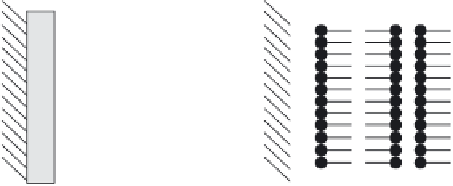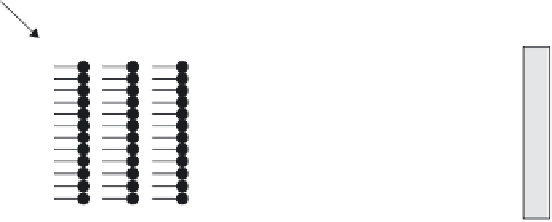Biomedical Engineering Reference
In-Depth Information
Solid substrate
Head-to-tail
Tail-to-tail
Head-to-head
Tail-to-head
X-type on a hydrophobic
surface
Y-type on a hydrophobic
surface
Z-type on a hydrophobic
surface
Figure 20.2.
Mono and multi layer of thin solid fi lms transferred from the air/water interface
to the solid supports.
the L
1
phase undergoes a transition to the Liquid Condensed state (L
2
) and even
at higher concentrations the monolayer reaches the Solid (S) state. If the mono-
layer is further compressed after reaching the S state, it will collapse into three-
dimensional structures.
Apart from these interfacial studies, LB apparatus could also be used for
transferring the mono- and multi-layers into solid substrates. The deposition
process is schematically illustrated in Figure 20.2. The LB deposition is tradition-
ally carried out in the solid phase. However, amphiphiles can seldom be success-
fully deposited at surface pressures lower than 10 mN/m and surface pressures
above 40 mN/m, due to lower fi lm rigidity-related problems. When the solid sub-
strate is hydrophilic, the fi rst layer is deposited by raising the solid substrate from
the subphase through the monolayer, whereas if the solid substrate is hydropho-
bic the fi rst layer is deposited by lowering the substrate into the subphase through
the monolayer. The deposited (supported) monolayers can be characterized by
various techniques including Transfer ratio. This is defi ned as the ratio between
the decrease in monolayer area during a deposition stroke and the area of the
substrate. A transfer ratio of one and above has been considered as a complete
wetting of the polymer surface by the monolayer
11
.
An alternative strategy to deposit the monolayer is Langmuir-Shaffer tech-
nique. This technique differs from the vertical technique described above only in
the sense that the solid substrate is horizontally lowered in contact with the
monolayer. The supported membranes have self-healing power and minimize
defects on the surface on formation
12
. Nissen et al. has studied the spreading
kinetics of the self-assembled monolayer over polymer substrates from a large
source of lipids using a fl uorescent dye. They demonstrated that the spreading
continues if the lipid reservoir is available in an air/water interface
13
and tend to
self - limiting fi ngered edges (due to pinning defects) at less supplementation, due







Search WWH ::

Custom Search